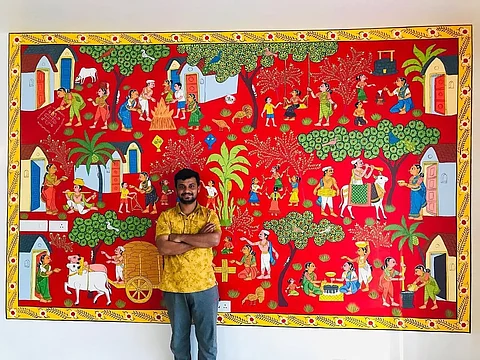
- Destinations
- Experiences
- Stay
- What's new
- Celebrating People
- Responsible Tourism
- CampaignsCampaigns
- SubscribeSubscribe
- Buy Now

“My grandfather warned me: if I didn’t keep painting, our entire lineage might have ended in the 1970s,” recalls Vinay Kumar, a Hyderabad-based Cheriyal artist who is the latest custodian of a tradition where vibrant panels once graced the temple ceilings of the Vijayanagara Empire.
Back in the 13th century, artisans wielded squirrel-hair brushes to trace mythic epics across plastered surfaces from Tamil Nadu to Karnataka. When Tipu Sultan’s armies felled the empire in the 1540s, these artists found refuge in Telangana’s Cheriyal village, carrying their art onto hand-prepared Khadi cloth. There, metres-long scrolls—painted in blazing red backgrounds, bold black outlines and flat washes of indigo, ochre and white—became mobile theatres for the “Ramayana,” “Mahabharata” and an array of local legends.
The youngest in a line of fifteen generations of nakashis—traditional Indian artisans who practice a centuries‑old folk craft in which a pliable ground made from rice starch and tamarind-seed paste is prepared on wood or metal, then carved and painted in vibrant relief designs by hand. Kumar first learned how to mix the pigments and pastes under the watchful eye of his father, D Vaikundam, a national award–winning painter.
By the time he turned eight, Kumar had mastered the ritual of grinding gaḍḍalu stones into red pigment, scooping lamp soot into velvety black and pulverising river shells into pure white. Each technique carried not only colour but cultural memory, connecting him back to his grandfather Venkat Ramayya—who single-handedly revived the art in the 1970s—and his father, whose national award and tireless exhibitions have kept the Takashi tradition alive.
Recognising their stewardship, the Telangana government granted Cheriyal painting Geographical Indication (GI) status in 2008 and today supports apprenticeship programs through its Handicrafts Development Board.
To prepare a scroll, Kumar begins by stretching Khadi cloth across a wooden frame. He then applies layer upon layer of a paste made from rice flour, white clay (“suddha matti”), tamarind-seed extract and tree gum, sprinkling fine sand between coats for resilience. Once cured, the surface holds the crispest strokes.
In a single, confident pass, he outlines figures—a profiled Ram, a stoic Krishna, devout villagers—using a slender squirrel-hair brush dipped in lamp soot ink. There is no room for hesitation; each line must dance with precision. Only then does he fill the panels: flat, unblended washes of red from gaḍḍalu stone, deep indigo from fermented leaves, warm ochre from ochre-stone and earthy browns from Geru mud. Turmeric-yellow highlights spark across garments and temple spires, while leaf-green emerges only when a special commission calls for a local twist.
“This economy of strokes, no shading, no gradients, makes every image instantly readable,” Vinay reflects. “It’s storytelling at its purest.”
In 2025, Vinay was one of 21 painters invited to the third edition of the ASEAN India Artists Camp, which was held from April 1 to 7 in Shillong under the theme “Echoes of Ramayana: Artistic Journeys Across ASEAN and India.”
Organised by India’s Ministry of External Affairs in collaboration with Seher, a New Delhi–based performing and visual arts organisation, participants from ASEAN member states, Timor‑Leste, and India engaged in public artwork, lectures, demonstrations and workshops that explored how the "Ramayana’s" universal themes resonate across cultures.
Kumar led sessions demonstrating the entire process of making a Cheriyal scroll from start to finish. His demos drew an enthusiastic response, with fellow artists experimenting by incorporating Cheriyal outlines into Thai, Cambodian and Filipino motifs.
Each month, Kumar teaches a workshop at his home to art students and craft enthusiasts. As they kneel beside the wooden frames, hands deep in jars of pigment, they learn to stretch tamarind-infused paste, to hold the squirrel-hair brush just so, and to trust that single, unbroken outline. “Teaching is part of our duty,” he says. “With every new apprentice, our lineage grows stronger.”
Inside Kumar’s Boduppal studio, the walls are lined with ancestral epics that tell the stories of a gouda toddy-tapper legend or capture the rhythms of a washer folk festival. These ancient dramas, once dozens of feet long, now reappear as compact wall hangings—an adaptation Kumar pioneered to suit modern interiors without sacrificing scale or spirit.
Where scrolls once measured up to 60 ft, Kumar now crafts three-foot miniatures, single-panel vignettes and even lampshades and phone covers printed with Cheriyal motifs. Yet authenticity remains his mantra: every piece still rests on handmade Khadi, bearing a hand-drawn outlineand gleaming with earth-based pigment.
In Telangana Shilparamam emporiums and at corporate gifting events, his works offer a living link to a centuries-old folk theatre, one that spans caste, community and countryside.
Looking to the future, Kumar envisions a dedicated Cheriyal centre in Hyderabad, where visitors might unroll full-length scrolls, hear oral recitations and attempt their first squirrel-hair strokes.
“Every scroll I paint is a conversation between past and present,” he says. “And through these strokes, the stories of our soil will whisper on.”
